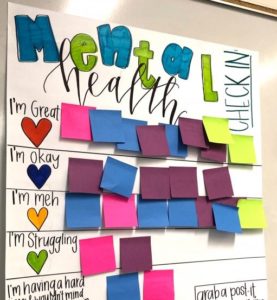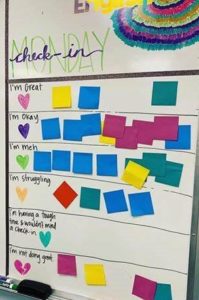Rapid Check-In Board
Overview
- Create a daily classroom Rapid Check-In board for students to share how they are doing every day. Below is a video of how one teacher utilizes a check-in board in her classroom.
Purpose
- This tool can be used by teachers within the classroom to easily and efficiently check-in with each student regarding their needs for that day.
- Students can share their feelings with the teacher without the need to approach him/her/them personally.
- Furthermore, the Rapid Check-In board can be orchestrated (see below) to allow students to remain anonymous to their fellow students while still being able to discreetly inform the teacher of their well-being.
- Such a tool may create an environment where students (especially those who are shy or quiet) will be more comfortable sharing their feelings with adults in the school.
Implementation
- Teachers should have their students use the classroom Rapid Check-In board daily (or whenever the personalization period or class where PASL is primarily being implemented meets).
Details
Building a Rapid Check-In Board
- Gather materials. The teacher will need to collect a base for the board (one may use a poster board, a section of a large dry erase board, etc.); markers, small buckets, and/or other instruments to decorate and organize the board; and items students may use to share their check-in information (i.e. post-its, painted bottle tops or popsicle sticks with student-assigned numbers on them, etc.)
- Decorate the base of the board. The base should include a title, as well as 4-6 progressive categories or descriptors to describe students’ social-emotional well-being (i.e. “I’m Great!”; “I’m Okay”, “I’m Meh”, “I’m struggling, but I’ll be alright”; “I’m having a hard time and would like to check-in”, etc.). Refer to examples below, found here and here.
- Locate the tools you would like to use to collect students’ check-in information and place these somewhere that are easily accessible to students. For example, you may use post-it notes, you could insert small boxes or buckets next to each category to collect student information using numbered popsicle sticks or painted bottle caps, you could have students write their student number in dry erase marker next to the most appropriate category (so as to retain anonymity from peers), etc.
- Please adapt and construct the Rapid Check-In board based on the capacity of your classroom and students’ needs.


Using a Rapid Check-In Board
- During each personalization period and/or primary class where PASL activities are implemented, students will enter the classroom and share how they are feeling that day.
- Depending on how the teacher chooses to construct his/her/their Rapid Check-In board, this may include writing their names or student numbers (and perhaps more detail describing their current well-being) on the back of a post-it note (to retain peer-peer anonymity) and sticking it next to the appropriate category; grabbing a painted bottle cap or popsicle sticks with their student number on it or writing their names and/or student numbers on a piece of scrap paper and putting the them in the appropriate bucket or box; etc.
- After students have shared their check-ins and are seated, the teacher may go to the board and collect this information while students complete their bell work or engage in another task.
- The teacher should pay special attention to those students who indicated that they are struggling and/or in need of someone to talk to.
- Ideally, teachers will then be able to check-in one-on-one with these students somewhere in or outside of the classroom where the conversation can remain discreet and is not overheard by other students.
- Following these check-ins, the teacher may prepare the Rapid Check-In board for the next class meeting. This may include removing and throwing away the post-it notes; having students individually collect their numbered bottle caps or Popsicle sticks before leaving the classroom; etc.
- It is important to note that teachers are still encouraged to check-in with each individual student regularly, regardless of whether or not the student consistently shares that he/she/they is “great” and appears to be doing well socially-emotionally and academically.
Connections to Other Components
- The Rapid Check-In board may be used in conjunction with other components, primarily Use of Data and Educator Teams.
- Teachers are encouraged to collect and record information discussed during rapid check-ins with students and share this information with relevant school personnel (especially if the student is struggling and in need of additional assistance beyond the classroom context).
Materials
- Materials will vary based on the teachers’ discretion.
- Items may include a bulletin board or dry erase board; markers; and post-it notes, buckets, boxes, painted bottle tops or Popsicle sticks with student numbers, etc.
Download full document here: Rapid-Check-In-Board (pdf); Rapid-Check-In-Board (doc)